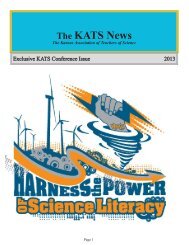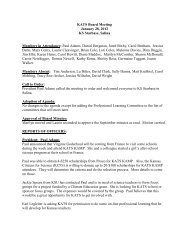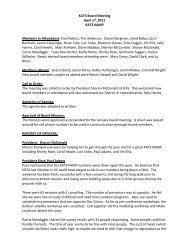Create successful ePaper yourself
Turn your PDF publications into a flip-book with our unique Google optimized e-Paper software.
page for details. Before conducting the<br />
investigation, review the concept of control.<br />
In this investigation, control will be how much<br />
the rubber band is stretched when launching<br />
the <strong>rocket</strong>s. The experimental variable will be<br />
the angle of launch. Students will compare<br />
the launch angle with the distance the <strong>rocket</strong><br />
travels. Organize students into teams of three.<br />
One student is the launcher. The second<br />
student confirms the launch angle and gives the<br />
launch command. The third student measures<br />
the launch distance, records it, and returns<br />
the <strong>rocket</strong> to the launch site for the next flight.<br />
The experiment is repeated twice more with<br />
students switching roles. The distances flown<br />
will be averaged. Teams will try different angles<br />
and determine what the best launch angle<br />
should be to obtain the greatest distance from<br />
the launch site.<br />
Background<br />
The foam <strong>rocket</strong> flies ballistically. It receives<br />
its entire thrust from the force produced by<br />
the elastic rubber band. The rubber band is<br />
stretched. When the <strong>rocket</strong> is released, the<br />
rubber band quickly returns to its original<br />
length, launching the foam <strong>rocket</strong> in the<br />
process. Technically, the foam <strong>rocket</strong> is a<br />
<strong>rocket</strong> in appearance only. The thrust of real<br />
<strong>rocket</strong>s typically continues for several seconds<br />
or minutes, causing continuous acceleration,<br />
until propellants are exhausted. The foam <strong>rocket</strong><br />
gets a quick pull and then coasts. Furthermore,<br />
the mass of the foam <strong>rocket</strong> doesn’t change<br />
in flight. Real <strong>rocket</strong>s consume propellants<br />
and their total mass diminishes. Nevertheless,<br />
the flight of a foam <strong>rocket</strong> is similar to that of<br />
real <strong>rocket</strong>s. Its motion and course is affected<br />
by gravity and by drag or friction with the<br />
atmosphere. The ability to fly foam <strong>rocket</strong>s<br />
repeatedly (without refueling) makes them ideal<br />
for classroom investigations on <strong>rocket</strong> motion.<br />
The launch of a foam <strong>rocket</strong> is a good<br />
demonstration of Newton’s third law of motion.<br />
The contraction of the rubber band produces<br />
an action force that propels the <strong>rocket</strong> forward<br />
while exerting an opposite and equal force on<br />
the launcher. In this activity, the launcher is a<br />
meter stick held by the student.<br />
Tip Be sure the range-measuring student<br />
measures where the <strong>rocket</strong> touches down and<br />
not where the <strong>rocket</strong> ends up after sliding or<br />
bouncing along the floor.<br />
In flight, foam <strong>rocket</strong>s are stabilized by<br />
their fins. The fins, like feathers on an arrow,<br />
keep the <strong>rocket</strong> pointed in the desired direction.<br />
If launched straight up, the foam <strong>rocket</strong> will<br />
climb until its momentum is overcome by<br />
gravity and air drag. At the very top of the flight<br />
the <strong>rocket</strong> momentarily becomes unstable.<br />
It flops over as the fins catch air. The <strong>rocket</strong><br />
becomes stable again when it falls back to the<br />
ground.<br />
When the foam <strong>rocket</strong> is launched at<br />
an angle of less than 90 degrees, its path is an<br />
arc whose shape is determined by the launch<br />
angle. For high launch angles, the arc is steep,<br />
and for low angles, it is broad.<br />
When launching a ballistic <strong>rocket</strong> straight<br />
up (neglecting air currents) the <strong>rocket</strong> will fall<br />
straight back to its launch site when its upward<br />
motion stops. If the <strong>rocket</strong> is launched at an<br />
angle of less than 90 degrees, it will land at<br />
some distance from the launch site. How far<br />
away from the launch site is dependent on four<br />
things. These are:<br />
gravity<br />
launch angle<br />
initial velocity<br />
atmospheric drag<br />
Gravity causes the foam <strong>rocket</strong> to<br />
decelerate as it climbs upward and then causes<br />
it to accelerate as it falls back to the ground.<br />
The launch angle works with gravity to shape<br />
the flight path. Initial velocity and drag affects<br />
the flight time.<br />
In the investigation, students will<br />
compare the launch angle to the range or<br />
distance the foam <strong>rocket</strong> lands from the<br />
launch site. Launch angle is the independent<br />
variable. Gravity can be ignored because the<br />
acceleration of gravity will remain the same for<br />
all flight tests. Atmospheric drag can also be<br />
ignored because the same <strong>rocket</strong> will be<br />
73










